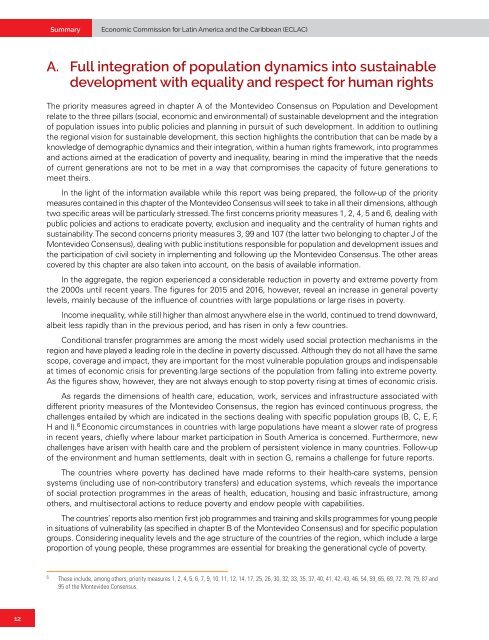Draft first regional report on the implementation of the Montevideo Consensus on Population and Development
This draft report seeks to give an account of progress in the implementation of the priority measures of the Montevideo Consensus on Population and Development in the region, as well as the differences between countries in terms of the degree of implementation. By highlighting relevant national experiences, it also seeks to facilitate the exchange of good practices among countries so that they can benefit from each other in their efforts to advance the implementation of the actions of the Montevideo Consensus.
This draft report seeks to give an account of progress in the implementation of the priority measures of the Montevideo Consensus on Population and Development in the region, as well as the differences between countries in terms of the degree of implementation. By highlighting relevant national experiences, it also seeks to facilitate the exchange of good practices among countries so that they can benefit from each other in their efforts to advance the implementation of the actions of the Montevideo Consensus.
You also want an ePaper? Increase the reach of your titles
YUMPU automatically turns print PDFs into web optimized ePapers that Google loves.
Summary<br />
Ec<strong>on</strong>omic Commissi<strong>on</strong> for Latin America <strong>and</strong> <strong>the</strong> Caribbean (ECLAC)<br />
A. Full integrati<strong>on</strong> <strong>of</strong> populati<strong>on</strong> dynamics into sustainable<br />
development with equality <strong>and</strong> respect for human rights<br />
The priority measures agreed in chapter A <strong>of</strong> <strong>the</strong> M<strong>on</strong>tevideo C<strong>on</strong>sensus <strong>on</strong> Populati<strong>on</strong> <strong>and</strong> <strong>Development</strong><br />
relate to <strong>the</strong> three pillars (social, ec<strong>on</strong>omic <strong>and</strong> envir<strong>on</strong>mental) <strong>of</strong> sustainable development <strong>and</strong> <strong>the</strong> integrati<strong>on</strong><br />
<strong>of</strong> populati<strong>on</strong> issues into public policies <strong>and</strong> planning in pursuit <strong>of</strong> such development. In additi<strong>on</strong> to outlining<br />
<strong>the</strong> <str<strong>on</strong>g>regi<strong>on</strong>al</str<strong>on</strong>g> visi<strong>on</strong> for sustainable development, this secti<strong>on</strong> highlights <strong>the</strong> c<strong>on</strong>tributi<strong>on</strong> that can be made by a<br />
knowledge <strong>of</strong> demographic dynamics <strong>and</strong> <strong>the</strong>ir integrati<strong>on</strong>, within a human rights framework, into programmes<br />
<strong>and</strong> acti<strong>on</strong>s aimed at <strong>the</strong> eradicati<strong>on</strong> <strong>of</strong> poverty <strong>and</strong> inequality, bearing in mind <strong>the</strong> imperative that <strong>the</strong> needs<br />
<strong>of</strong> current generati<strong>on</strong>s are not to be met in a way that compromises <strong>the</strong> capacity <strong>of</strong> future generati<strong>on</strong>s to<br />
meet <strong>the</strong>irs.<br />
In <strong>the</strong> light <strong>of</strong> <strong>the</strong> informati<strong>on</strong> available while this <str<strong>on</strong>g>report</str<strong>on</strong>g> was being prepared, <strong>the</strong> follow-up <strong>of</strong> <strong>the</strong> priority<br />
measures c<strong>on</strong>tained in this chapter <strong>of</strong> <strong>the</strong> M<strong>on</strong>tevideo C<strong>on</strong>sensus will seek to take in all <strong>the</strong>ir dimensi<strong>on</strong>s, although<br />
two specific areas will be particularly stressed. The <str<strong>on</strong>g>first</str<strong>on</strong>g> c<strong>on</strong>cerns priority measures 1, 2, 4, 5 <strong>and</strong> 6, dealing with<br />
public policies <strong>and</strong> acti<strong>on</strong>s to eradicate poverty, exclusi<strong>on</strong> <strong>and</strong> inequality <strong>and</strong> <strong>the</strong> centrality <strong>of</strong> human rights <strong>and</strong><br />
sustainability. The sec<strong>on</strong>d c<strong>on</strong>cerns priority measures 3, 99 <strong>and</strong> 107 (<strong>the</strong> latter two bel<strong>on</strong>ging to chapter J <strong>of</strong> <strong>the</strong><br />
M<strong>on</strong>tevideo C<strong>on</strong>sensus), dealing with public instituti<strong>on</strong>s resp<strong>on</strong>sible for populati<strong>on</strong> <strong>and</strong> development issues <strong>and</strong><br />
<strong>the</strong> participati<strong>on</strong> <strong>of</strong> civil society in implementing <strong>and</strong> following up <strong>the</strong> M<strong>on</strong>tevideo C<strong>on</strong>sensus. The o<strong>the</strong>r areas<br />
covered by this chapter are also taken into account, <strong>on</strong> <strong>the</strong> basis <strong>of</strong> available informati<strong>on</strong>.<br />
In <strong>the</strong> aggregate, <strong>the</strong> regi<strong>on</strong> experienced a c<strong>on</strong>siderable reducti<strong>on</strong> in poverty <strong>and</strong> extreme poverty from<br />
<strong>the</strong> 2000s until recent years. The figures for 2015 <strong>and</strong> 2016, however, reveal an increase in general poverty<br />
levels, mainly because <strong>of</strong> <strong>the</strong> influence <strong>of</strong> countries with large populati<strong>on</strong>s or large rises in poverty.<br />
Income inequality, while still higher than almost anywhere else in <strong>the</strong> world, c<strong>on</strong>tinued to trend downward,<br />
albeit less rapidly than in <strong>the</strong> previous period, <strong>and</strong> has risen in <strong>on</strong>ly a few countries.<br />
C<strong>on</strong>diti<strong>on</strong>al transfer programmes are am<strong>on</strong>g <strong>the</strong> most widely used social protecti<strong>on</strong> mechanisms in <strong>the</strong><br />
regi<strong>on</strong> <strong>and</strong> have played a leading role in <strong>the</strong> decline in poverty discussed. Although <strong>the</strong>y do not all have <strong>the</strong> same<br />
scope, coverage <strong>and</strong> impact, <strong>the</strong>y are important for <strong>the</strong> most vulnerable populati<strong>on</strong> groups <strong>and</strong> indispensable<br />
at times <strong>of</strong> ec<strong>on</strong>omic crisis for preventing large secti<strong>on</strong>s <strong>of</strong> <strong>the</strong> populati<strong>on</strong> from falling into extreme poverty.<br />
As <strong>the</strong> figures show, however, <strong>the</strong>y are not always enough to stop poverty rising at times <strong>of</strong> ec<strong>on</strong>omic crisis.<br />
As regards <strong>the</strong> dimensi<strong>on</strong>s <strong>of</strong> health care, educati<strong>on</strong>, work, services <strong>and</strong> infrastructure associated with<br />
different priority measures <strong>of</strong> <strong>the</strong> M<strong>on</strong>tevideo C<strong>on</strong>sensus, <strong>the</strong> regi<strong>on</strong> has evinced c<strong>on</strong>tinuous progress, <strong>the</strong><br />
challenges entailed by which are indicated in <strong>the</strong> secti<strong>on</strong>s dealing with specific populati<strong>on</strong> groups (B, C, E, F,<br />
H <strong>and</strong> I). 6 Ec<strong>on</strong>omic circumstances in countries with large populati<strong>on</strong>s have meant a slower rate <strong>of</strong> progress<br />
in recent years, chiefly where labour market participati<strong>on</strong> in South America is c<strong>on</strong>cerned. Fur<strong>the</strong>rmore, new<br />
challenges have arisen with health care <strong>and</strong> <strong>the</strong> problem <strong>of</strong> persistent violence in many countries. Follow-up<br />
<strong>of</strong> <strong>the</strong> envir<strong>on</strong>ment <strong>and</strong> human settlements, dealt with in secti<strong>on</strong> G, remains a challenge for future <str<strong>on</strong>g>report</str<strong>on</strong>g>s.<br />
The countries where poverty has declined have made reforms to <strong>the</strong>ir health-care systems, pensi<strong>on</strong><br />
systems (including use <strong>of</strong> n<strong>on</strong>-c<strong>on</strong>tributory transfers) <strong>and</strong> educati<strong>on</strong> systems, which reveals <strong>the</strong> importance<br />
<strong>of</strong> social protecti<strong>on</strong> programmes in <strong>the</strong> areas <strong>of</strong> health, educati<strong>on</strong>, housing <strong>and</strong> basic infrastructure, am<strong>on</strong>g<br />
o<strong>the</strong>rs, <strong>and</strong> multisectoral acti<strong>on</strong>s to reduce poverty <strong>and</strong> endow people with capabilities.<br />
The countries’ <str<strong>on</strong>g>report</str<strong>on</strong>g>s also menti<strong>on</strong> <str<strong>on</strong>g>first</str<strong>on</strong>g> job programmes <strong>and</strong> training <strong>and</strong> skills programmes for young people<br />
in situati<strong>on</strong>s <strong>of</strong> vulnerability (as specified in chapter B <strong>of</strong> <strong>the</strong> M<strong>on</strong>tevideo C<strong>on</strong>sensus) <strong>and</strong> for specific populati<strong>on</strong><br />
groups. C<strong>on</strong>sidering inequality levels <strong>and</strong> <strong>the</strong> age structure <strong>of</strong> <strong>the</strong> countries <strong>of</strong> <strong>the</strong> regi<strong>on</strong>, which include a large<br />
proporti<strong>on</strong> <strong>of</strong> young people, <strong>the</strong>se programmes are essential for breaking <strong>the</strong> generati<strong>on</strong>al cycle <strong>of</strong> poverty.<br />
6<br />
These include, am<strong>on</strong>g o<strong>the</strong>rs, priority measures 1, 2, 4, 5, 6, 7, 9, 10, 11, 12, 14, 17, 25, 26, 30, 32, 33, 35, 37, 40, 41, 42, 43, 46, 54, 59, 65, 69, 72, 78, 79, 87 <strong>and</strong><br />
95 <strong>of</strong> <strong>the</strong> M<strong>on</strong>tevideo C<strong>on</strong>sensus.<br />
12


















